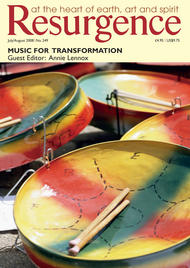“THERE IS A lot of blood in our food,” says Raj Patel, when I asked why he wrote this book. He wants to make us more informed, angry, and then to act – not only in our daily lives but as citizens reshaping the political agenda. Only then will we combat “the concerns of food production companies [which] are the rot at the core of the modern food system”.
He sees a growing urban/rural disconnect globally in which the rural poor suffer most. Yet he finds hope that it is rural people in many poorer countries who are resisting the expansion of globalisation and showing alternative ways to create our future.
As in Steinbeck’s Grapes of Wrath, he finds “a rule, as true in the United States as in India is this: farmers who kill themselves have been scythed by debt.” He argues that “globalising the market has effectively transferred control of farming away from the farmer, and into the hands of those who can shape the market.” It is a market in which a few big players increasingly dominate – from food traders, processors and retailers to input suppliers and caterers.
Many of the themes Patel deals with will be familiar to Resurgence readers but perhaps not the specific instances he describes, as he draws on both US and South African examples as well as international ones. He ranges widely through the contemporary and historical connections – from Mexico’s trade agreements and what has happened with corn (maize) and back into the history of sugar and tea – the original caffeinated drink to keep the workers moving.
The UK has a huge responsibility for shaping today’s global food production system through its empire and the desire to feed a potentially unruly, industrial workforce cheaply. The US took over the reshaping role after the Second World War, partly through its use of food aid, then agricultural technologies, and finally reshaping the rules and the institutions governing the system. His account of the expansion of soybean cultivation shows this owes its origins to the continuation of a war economy after the end of the war. Soya now extends its reach globally, through power politics in Brazil and far beyond. Patel notes other links between war and food, too – from dealing with scurvy, to the invention of canning, to the role of invading armies in changing food habits.
However, today it is not governments that control things but increasingly large, transnational corporations, one of whose chiefs he quotes as saying, “The competitor is our friend and the customer is our enemy.” Corporate wealth pays for lobbying, which helps shape the rules of the system in corporate interests – although usually couched as being in our interests. Large corporations also increasingly drive the direction of scientific research and technical developments – so these are not aimed at either the poor or being ecologically appropriate.
The illustration for the US patent for the first supermarket design is very revealing. Its inventor, Clarence Saunders, aimed to cut staff costs and maximise customer spending, creating “the first consumption factory”.
At a time when we are increasingly swamped by a media focus on food and the consumer end of the system, this book has a refreshing focus on power, control, work and politics, and the bigger interests that drive the changing dynamics of the food system. To tackle those, we need more than personal actions: we need political actions – some of which are being pioneered in the South through the farmers and peasant movements, which Patel discusses.
Many of the ten points for action are familiar. They include transforming our tastes, eating locally, seasonally and agro-ecologically, supporting locally owned businesses, ensuring that all workers have the right to dignity and living wages for all, support for a ‘sustainable architecture’ of food, and snapping the food system’s choke-holds of control. By far the most radical is the call for us in the global North to own and provide restitution for the injustices of the past and present. This includes debt cancellation, but goes much deeper.
In keeping with the internet age, the book does not finish on the last page. Patel has set up a website with further details, resources and background. He runs a blog to keep readers informed, and plans to send out thought-
provoking information about developments in the food system – see www.stuffedandstarved.org
Geoff Tansey’s latest book is The Future
Control of Food (Earthscan, 2008).






